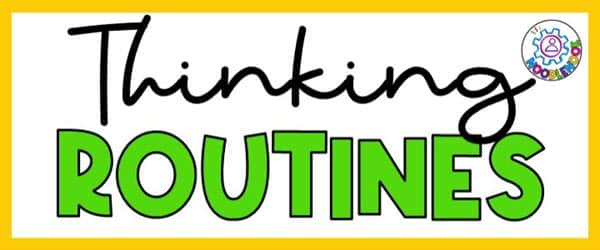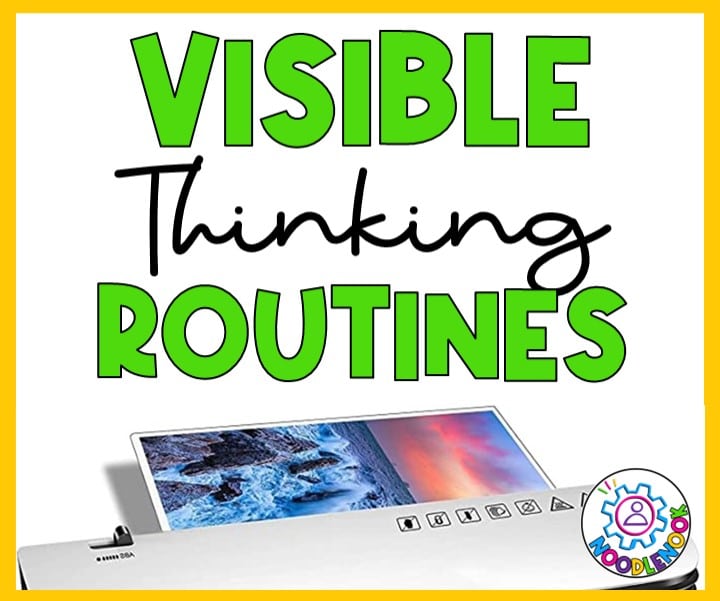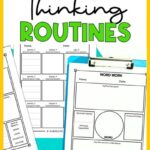Visible Thinking Routines are powerful tools that support students’ learning and help make thinking processes visible in a classroom environment. This can make a huge difference in special education where many of our students struggle with explaining or vocalizing their thought process. Thinking routines are a research-based approach that originates from Harvard University’s Graduate School of Education. It provides educators with a structured and adaptable framework to guide learners through different processes. Even though that sounds a little stuffy the truth is you’ve probably been using thinking routines for a long time. Let’s get into how visual thinking routines are the best visual tools in special education.
What Is a Visible Thinking Routine?
Visible thinking routines aren’t just a theoretical concept. My guess is you’ve been using these practical tools in your classroom for a long time. If you’ve ever asked your students to think-pair-share in small groups to discuss a set of questions or to use a graphic organizer as visual support for content learning, then you’re already an adopter!
Simply put, visual thinking routines are a way of organizing ideas. They support students’ thinking and help them in understanding a topic. These can be especially useful when a student with a disability is learning new ideas or trying to get a better understanding of a topic. If you’ve ever worked with a student who’s challenged with communication or text-based discussion, then you know how critical visual support can be. With a short sequence of steps, visual learners can apply a type of thinking to help get different perspectives, garner a deeper understanding, or just complete tasks that the rest of the class is doing. With the improvement of technology tools available, simple routines paired with patterns of action can help close the gap for a student with a disability.
Why Are Visible Thinking Routines Important in Special Ed?
Thinking routines are a flexible framework that help by making thinking visible. This makes our role of the teacher easier. We can see how a student is thinking, we can help them with different types of support or assistive technology. Seeing how their minds work is mindblowing. More importantly, though, we can help students develop critical thinking skills. When we highlight how a specific type of tool in the thinking routines toolbox can provide simple structures that support understanding, students learn more the first time around.
In other words, visible thinking routines for special ed students has these key benefits:
- They support students’ curiosity and wonder, motivating them to explore new ideas and perspectives.
- They help students develop critical thinking skills, such as analyzing, evaluating, finding complexity, and making connections.
- They provide students with visual tools and structures that scaffold their learning and help them express their thoughts.
- They reveal students’ thinking to the teacher and to themselves, allowing for feedback and reflection.
For years teachers have been asked to tap into a student’s prior knowledge in order to enhance learning through personal experiences. The problem with this framework for students with disabilities is that their set of personal experiences may be limited. In order to get around this, we rely on quality pre-teaching and tapping into student interest to compensate. Sometimes this works, but it’s not consistent in a variety of contexts. In order to help students with disabilities in exploring ideas, problem-solving, and artful thinking, we need visual thinking strategies.
How Can I Implement a Visible Thinking Routine with A Student?
One of the best places to start when it comes to establishing core thinking routines that support student thinking is the Harvard Graduate School of Education website. There are comprehensive guides that help you find the right tool. You will also find a short video that helps explain thinking routines on the site.
Thinking routines work with many age groups, from toddlers to older students. It also works across content areas. That means taking time to teach a quality visible thinking routine is not a waste of students time.
To implement these routines, use this simple implementation process:
- Select the Right Routine: Begin by choosing the appropriate thinking routine based on the specific topic, age group, and learning objectives. Ensure that the routine aligns with your teaching goals.
- Explain the Routine: Clearly introduce the thinking routine to your students. Explain the purpose and how it will benefit their learning. It’s essential that students understand why they are using this routine.
- Model the Process: As the teacher, model the thinking routine to the students. Walk them through how it works, thinking out loud to demonstrate the process.
- Provide Opportunities for Practice: Give students the chance to practice the routine in a safe and structured environment. This could involve working in small groups, which encourages peer-to-peer learning and exploration of ideas.
- Incorporate Feedback: Encourage students to provide feedback to each other. This can help them refine their thinking and understand the value of different perspectives.
- Reflect and Discuss: After completing the routine, engage the class in a discussion about their experience. Ask questions to help them think about the process, what they learned, and how it contributed to their understanding of the topic.
One simple warning for special education teachers: Choose a single thinking routine to implement at a time. Start with one that you think can target several key goals a student is working on or improve a student’s overall classroom experience. Then teach that routine by modeling the process offering lots of practice until a student is near mastery before introducing and incorporating the next routine. You want your students to become nearly independent in applying these thought processes, so lots of practice with just ONE routine at a time is essential.
What are Some Visible Thinking Routines?
Many types of visual thinking routines can be used for different purposes and contexts within the special education setting. When you consistently include them in your lesson plans as part of your student’s process of learning, they become part of the fabric of the classroom. Then that happens, your student learning becomes internalized and a brief sequence of steps becomes habit. That is lifelong! As a conceptual framework, these are a good place to start:
- See, Think, Wonder: A routine that helps students observe and interpret an image, object, or phenomenon, and generate questions for further inquiry.
- Circle of Viewpoints: A routine that helps students explore diverse perspectives on an issue or topic, and understand the reasons behind them.
- Claim, Support, Question: A routine that helps students make and evaluate claims based on evidence, and identify gaps or uncertainties in their reasoning.
- Headline: A routine that helps students capture the essence or core idea of a topic or issue.
Personally, I love the headline routine! It’s so simple, but so helpful. It involves writing a headline that summarizes the most important aspect of the topic or issue. As students apply headlines over a period of time on a single topic, they can compare their current headline with previous or alternative headlines. It’s perfect at the end of class or a small group session to quickly assess what a student understands about a topic. It can also be done in small group intervention settings to process through how to identify the most important thing.
Where Can I Learn More About Different Visible Thinking Routines?
Start with the Harvard Graduate School of Education website. There are a lot of routines listed, which can be a little intimidating. Start with broader routines like compass points, circle of viewpoints, headlines, and think-pair-share. I also love ‘what makes you think so?’
RECAP: Visible Thinking Routines in Special Ed
Visible thinking routines offer valuable support in special education. They help students express their thoughts and cater to diverse learning needs. Whether you’re experienced or new to these routines, their impact on students with disabilities is clear and they are an instructional best practice. The use of thinking routines can help students with communication challenges and adapt to individual requirements, fostering critical thinking skills. By using these routines, teachers help their students to explore ideas, solve problems, and develop their thinking. So what are you waiting for? Get started with visual thinking routines in your classroom today!
FAQ: Top TIPS For Using a Visible Thinking Routine in Special Ed
- How can visible thinking routines be modified to accommodate the diverse needs of students with disabilities? Visible thinking routines are versatile, and you can adapt them to meet the unique requirements of students with disabilities. This may involve simplifying steps, providing additional visual aids, or offering alternative communication methods.
- What are some strategies to encourage active participation from students with disabilities when using visible thinking routines? To promote engagement, consider incorporating multi-sensory elements, encouraging peer collaboration, and using technology tools that support students with disabilities in the thinking routine process.
- Are there specific visible thinking routines that work exceptionally well for students with certain disabilities, such as autism or dyslexia? While many thinking routines can benefit students with disabilities, some may align more closely with specific needs. For example, “See-Think-Wonder” may be particularly effective for students on the autism spectrum due to its visual focus.
- How can teachers ensure that the pace of a thinking routine accommodates the processing speed of students with learning disabilities? Adjust the pace to match the individual student’s processing speed. Provide additional time for thinking and responding, allowing students with learning disabilities to fully engage and express their thoughts.
- What support and training are available for teachers in implementing visible thinking routines effectively with students who have disabilities? There are various professional development opportunities and resources designed to help teachers support students with disabilities through visible thinking routines. Consider seeking out workshops, online courses, or mentorship programs in your specific area of focus.
If you love graphic organizers and want to use them to develop a thinking process with students, check out this set from Noodle Nook. CLICK HERE for GRAPHIC ORGANIZERS!




